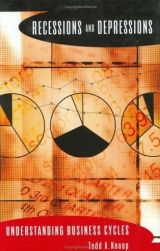


|
|
Recessions and Depressions: Understanding Business Cycles (Hardcover)
by Todd A. Knoop
| Category:
Economy |
| Market price: ¥ 580.00
MSL price:
¥ 448.00
[ Shop incentives ]
|
| Stock:
Pre-order item, lead time 3-7 weeks upon payment [ COD term does not apply to pre-order items ] |
MSL rating:
 Good for Gifts Good for Gifts |
| If you want us to help you with the right titles you're looking for, or to make reading recommendations based on your needs, please contact our consultants. |

Detail |

Author |

Description |

Excerpt |

Reviews |
|
|
|
Author: Todd A. Knoop
Publisher: Praeger Publishers
Pub. in: July, 2004
ISBN: 0275981622
Pages: 312
Measurements: 9.4 x 6 x 1.3 inches
Origin of product: USA
Order code: BA01693
Other information: ISBN-13: 978-0275981624
|
|
Rate this product:
|
|
Customers who bought this product also bought:
|
|
TODD A. KNOOP is Associate Professor of Economics and Business at Cornell College, where his primary research and teaching interests include macroeconomic theory, tax reform, and monetary policy. He has published many articles in such journals as Economic Inquiry and the Southern Economic Journal.
|
|
From publisher
The economy of any nation is an intricate web of relationships among the factors determining supply and demand-and everything that affects them, from inflation to taxes to the stock market. The study of business cycles attempts to explain why economies grow and contract, experiencing periods of prosperity and pain. Consistent with the popular conception of economics as the "dismal science," economists secretly long for recessions (periods of negative growth) and depressions (severe contractions), not because they enjoy their devastating impact on human welfare, but because these downturns serve as excellent laboratories for observing what happens when markets break down. Despite over two centuries of debate, no one has yet definitively unlocked the secrets of economic downturns and how they might be prevented. In Recessions and Depressions Todd Knoop traces the evolution of business cycle theory, from the "classical" model, which preceded the Great Depression, through the ground-breaking ideas of John Maynard Keynes, Milton Friedman, and their followers. He examines the strengths and limitations of each approach, in terms of explaining the impact of such factors as government policy, money supply, labor productivity, and wages. In the process, he presents an accessible introduction to what makes the economy tick, and offers new insights into understanding such historic events as the Great Depression, as well as more recent ones, such as the Asian meltdown in the 1990s, the financial crises in Latin America, and the U.S. recession of 2001, from which the United States is still recovering. Knoop reminds us that economists' track record in forecasting business cycles leaves much to be desired, and the quest to fully understand what causes economic downturns--and their effects on individuals and families-continues.
|
Choice (MSL quoted), USA
<2009-02-26 00:00>
Knoop admirably achieves his stated objective of producing a teaching text. The result is simultaneously an informative, readable, balanced, and worthwhile work that will be an appealing primary or ancillary text for advanced macro classes or seminars. Highly recommended. Informed general readers; upper-division undergraduates through professionals. |
EH.NET, USA
<2009-02-26 00:00>
[K]noop's discussion of the problems of macroeconomic forecasting, whether through the use of leading economic indicators, market indicators, or econometric models, is highly informative and insightful...[t]his book should be accessible to students, and they will gain a good deal of information about, and a fair understanding of, business cycles from reading it. |
CFO Magazine , USA
<2009-02-26 00:00>
[E]xcellent scholarly introduction to business cycles. |
|
|
|
|